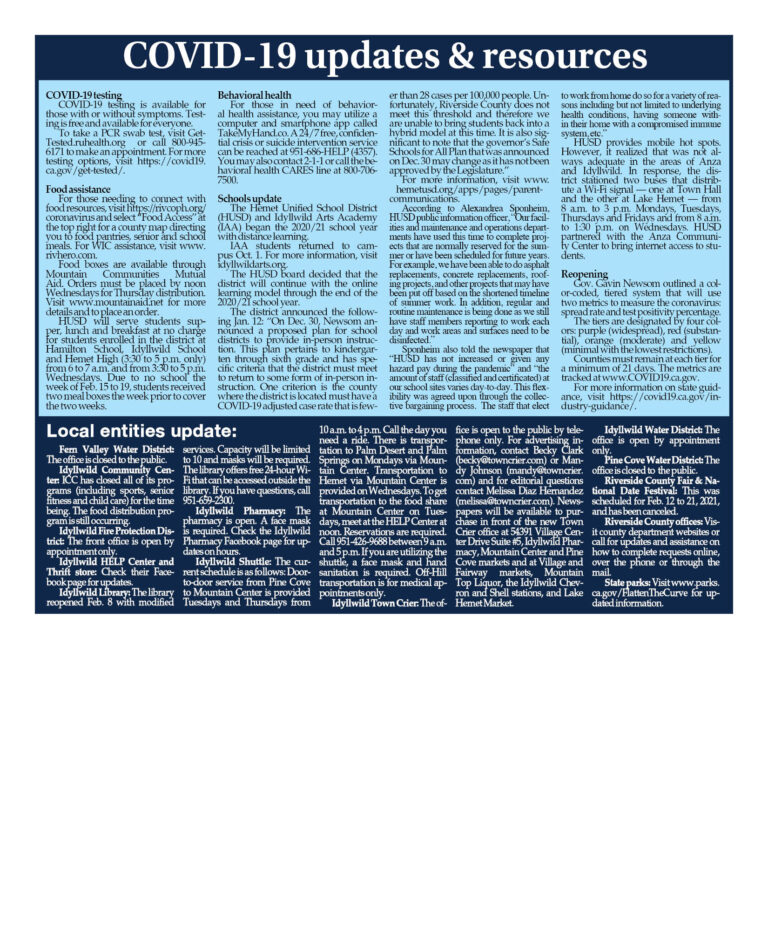Prop 4 $10 billion in bonds for environmental projects
Editor’s note: There are 10 propositions on the Nov. 5 Presidential Election ballot. Props 2 and 4 are requesting approval for the State to issue $20 billion in new bonds. Prop 2 funds are for education facilities, such K–12 public schools (including charter schools) and community colleges. Proceeds authorized by Prop 4 would go toward water, wildfire prevention, and protection of communities and lands. Both Props are described in this issue of the Town Crier.
Proposition 4
Proposition 4 authorizes the State to borrow $10 billion to fund various activities aimed at conserving natural resources, as well as responding to the causes and effects of climate change.
The borrowing would be allocated to various programs and projects. The largest amount, $3.8 billion, would be directed to drought, flood, and water supply projects. Wildfire prevention and extreme heat mitigation work would together receive $1.95 billion. Another $1.9 billion is targeted for protection of natural lands, parks, and wildlife and $1.2 billion for protection of coastal lands, bays, and oceans. Clean energy projects would have $850 million available and the final $300 million is for agriculture projects.
Prop 4 language would give priority to projects benefiting disadvantaged communities. According to the Legislative Analyst’s Office, 40 % of funding will be allocated to these projects. And, like Prop 2, repayment of the bonds overtime would come directly from the General Fund.
The LAO estimated that repayment of the bonds would cost the State about $400 million annually over a 40-year period. Prop 4 likely would result in savings to local governments. The amount of these savings is uncertain.
Both the Assembly and State Senate approved placing Prop 4 on the November Presidential Ballot. The Assembly vote was 66-6 and the Senate approved it by 33-6.
Allocation of bond funds
About half of the water project money is for activities to increase the amount and quality of water available for people to use. Examples include water storage and water purification projects. Reducing the risk of floods, repairing dams and capturing stormwater for reuse stormwater projects are allocated $1.1 billion. River and lake restoration projects are also included in this group.
Forest health and wildfire prevention projects are intended to reduce the risk of severe and destructive wildfires. This work includes tree thinning and vegetation clearing near homes and structures.
About three-quarters of the coastal land and ocean project funding is aimed for restoration of coastal areas. The intent is to protect them from rising sea levels. Restoration of wetlands can serve as buffers to rising sea levels. The remaining funding would be allocated for improvement of ocean habitats for fish and other marine wildlife.
The land conservation money will be used to protect wildlife habitat and recreational lands, either purchase or protection of existing public acreage. Examples include construction of new trails and parking areas, repair existing state park facilities, and construction of new parks or renovation of existing parks in local communities.
The clean energy projects will focus on building wind turbines off the State coast and building energy infrastructure such as transmission lines or large batteries to store electricity.
Another $450 million would add trees and greenspaces to localities or construction of safe places to address extreme heat problems.
The final area of funding is for agricultural projects, such improving soil health and reducing air pollution and water consumption. It could also be used to acquire transportation for farmworkers and conserving farmland.
Supporters
The proponents, including the President of the CalFire firefighters, all argue that Prop 4 is needed and will help improve California’s environments and protect public safety.
Opponents
The opposition to Prop 4 first argues that bonds are an expensive means to pay for these types of projects. Over the repayment period, the cost of borrowing will nearly double with the interest paid. “Bonds should be reserved for financing essential projects that will build infrastructure lasting beyond the 30-year payoff period. However, many elements of Proposition 4 fail to meet that standard,” opponents, including Jon Coupal, President of the Howard Jarvis Taxpayers Association.
If critical, these projects should be funded directly in the budget, they argue. If not, then they are simply pet projects. Too much of Prop 4 of money will fund unproven technologies. One result, they conjecture, is Prop 4 favors short-term, unproven projects over long-term water storage and critical wildfire fuel management programs.
“Vital programs should be funded in the budget with the taxes we already pay, not through costly borrowing. What’s in the budget that’s a higher priority than safe drinking water and wildfire prevention?” opponents opine.
More specifically, Senate Minority Leader Brian Jones (R 40) wrote in a Cal Matters opinion piece, “Prop. 4 will spend millions on so-called ‘infrastructure’ for farmers’ markets — things like pop-up tents, restrooms and hand-washing stations. . . the bond also includes grants for exhibit galleries at zoos and museums, and even vanpool vehicles for low-income workers.
“Does that sound like climate-related infrastructure? While these programs may be worth pursuing, they shouldn’t be funded with long-term debt. Again, bonds should only be used for long-term investments, not temporary programs that will be gone before the debt is paid off,” he argued.
Financial support
There are two political action committees supporting Prop 4.
The committee for Clean Water Natural Resources and Parks – Yes on Proposition 4, sponsored by a coalition of environmental advocates across California, had $152,000 in cash as of Sept. 23. Since July 1, they had spent $520,000.
The “Yes on Prop 4, Californians for safe drinking water and wildfire prevention, sponsored by environmental organizations” had no funds on July 1.
Since the end of July, conservation groups have given nearly $3.2 million. The largest contributors have been The Nature Conservancy ($1 million), the California Council of Land Trusts Action Fund ($750,000) and the California Trust for Public Lands ($575,000). Also, the Clean Water Natural Resources and Parks – Yes on Proposition 4 gave this PAC $500,000.
Poll results
Of all likely voters, nearly 65% would vote for Prop 4. And 32% of voters say the outcome is “very important” to them, according to the latest Public Policy Institute of California poll. Regardless of gender or education, a majority favored Prop 4. The San Francisco Bay area support was the greatest at 74%, while 64% of Inland Empire voters were for it.



